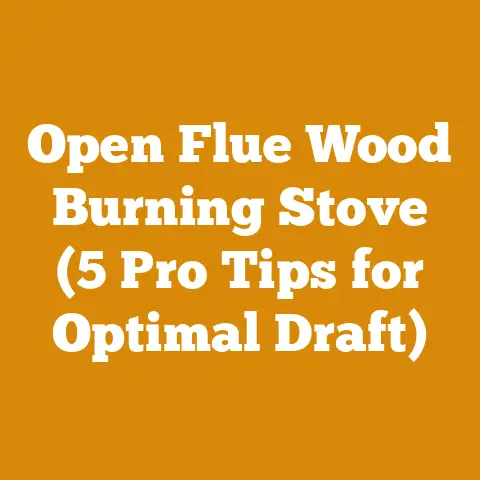How to Cut Fire Brick (5 Pro Tips for Perfect Stove Linings)
Cutting fire brick might seem like a task best left to professionals, but trust me, with the right approach, anyone can achieve clean, precise cuts for their stove linings. I’ve spent years tinkering with wood stoves, building outdoor ovens, and generally messing about with anything that burns wood. And in that time, I’ve learned that a well-lined firebox is crucial for efficiency and longevity. That’s why I’m going to share my top five pro tips for cutting fire brick, ensuring your stove or fireplace performs optimally.
Why Cutting Fire Brick Matters
Before we dive into the how-to, let’s quickly touch on the why. Fire brick is designed to withstand incredibly high temperatures without cracking or degrading. This protects the outer shell of your stove or fireplace, preventing heat damage and prolonging its lifespan. A properly fitted fire brick lining also helps to reflect heat back into the firebox, leading to more efficient combustion and less wasted fuel. If you don’t have the right size fire bricks, cutting them becomes essential to create a snug and effective lining.
Understanding Fire Brick
Fire brick isn’t your average brick. It’s made from refractory ceramic materials like fireclay, alumina, silica, and magnesite. These materials give it its exceptional heat resistance.
- Standard Size: Typically, fire bricks come in standard sizes, often around 9 x 4.5 x 2.5 inches. However, variations exist.
- Density: They are denser than regular bricks, contributing to their heat-resistant properties.
- Types: Different types of fire brick are available, each rated for specific temperatures. Make sure you choose the right brick for your application.
Pro Tip #1: Choosing the Right Tool
The tool you use will significantly impact the quality of your cut. While a brick hammer and chisel can work, they often lead to uneven edges and potential cracking. For clean, precise cuts, I highly recommend a wet tile saw.
Wet Tile Saw: My Go-To
A wet tile saw uses a diamond blade cooled by water to slice through the brick with minimal chipping. I personally use a Dewalt D24000S, but any reputable brand with a decent-sized water tray will do.
- Why Wet? The water not only keeps the blade cool, preventing overheating and warping, but also minimizes dust, which is a major health hazard when cutting fire brick.
- Diamond Blade: Ensure you have a continuous rim diamond blade designed for cutting masonry. Segmented blades can cause more chipping. A 7-inch blade is usually sufficient for most fire brick.
- Cost: Wet tile saws can range from $100 to $500 or more. A good quality mid-range saw will serve you well for years.
My Story: I once tried cutting fire brick with a dry angle grinder with a diamond blade. The dust was unbearable, even with a respirator, and the cuts were rough and uneven. Switching to a wet tile saw was a game-changer.
Alternative Tools
- Angle Grinder with Diamond Blade (Dry Cutting): While I don’t recommend it for the reasons mentioned above, if you must use an angle grinder, ensure you have proper dust collection and wear a NIOSH-approved respirator.
- Brick Hammer and Chisel: This is the most basic option, but it requires skill and patience. Expect some waste and potential for less-than-perfect cuts.
- Masonry Saw: A larger, more powerful saw designed for cutting bricks and concrete. It’s overkill for most fire brick projects but useful if you’re doing a lot of cutting.
Pro Tip #2: Safety First!
Cutting fire brick generates dust that can be harmful to your lungs. Safety is paramount.
- Respirator: Always wear a NIOSH-approved respirator to protect yourself from silica dust. Don’t skimp on this!
- Eye Protection: Safety glasses or a face shield are essential to protect your eyes from flying debris.
- Gloves: Wear gloves to protect your hands from the abrasive surface of the brick and potential cuts.
- Hearing Protection: Wet tile saws can be noisy. Consider wearing earplugs or earmuffs.
- Ventilation: Work in a well-ventilated area, preferably outdoors.
- Water Management: Be mindful of the water spray from the wet tile saw. Protect surrounding surfaces and wear appropriate clothing.
Data Point: Studies have shown that prolonged exposure to silica dust can lead to silicosis, a serious lung disease. Investing in proper safety equipment is a small price to pay for your health.
Pro Tip #3: Precise Measurement and Marking
Accurate measurements are crucial for a snug and efficient fire brick lining. Take your time and double-check your measurements before cutting.
- Measure Twice, Cut Once: This old adage applies perfectly here. Measure the area you need to line and carefully transfer those measurements onto the fire brick.
- Use a Sharpie or Permanent Marker: A Sharpie works well for marking fire brick. The lines are clear and easy to see.
- Consider the Kerf: The kerf is the width of the saw blade. When marking your cuts, account for the kerf to ensure your final piece is the correct size. I typically add the width of the blade (usually around 1/8 inch) to my measurements.
- Dry Fit: Before permanently installing any fire brick, dry-fit the pieces to ensure they fit properly. This will help you identify any potential problems and make adjustments before it’s too late.
Case Study: I was relining a wood stove and miscalculated the kerf. As a result, my fire brick was slightly too small, leaving gaps in the lining. I had to recut several pieces, wasting time and materials. Learn from my mistake!
Pro Tip #4: Mastering the Cutting Technique
The cutting technique is just as important as the tool you use. A slow, steady approach will yield the best results.
- Slow and Steady Wins the Race: Don’t force the brick through the blade. Let the blade do the work. Applying too much pressure can cause the blade to bind or the brick to chip.
- Score the Brick: Before making a full cut, score the brick along your marked line. This helps to prevent chipping and ensures a clean, straight cut.
- Multiple Passes: For thicker fire brick, consider making multiple shallow passes rather than trying to cut through the entire brick in one go. This will reduce stress on the blade and minimize the risk of chipping.
- Cool the Blade: If you’re cutting a lot of fire brick, the blade can overheat. Take breaks to allow the blade to cool down. You can also add ice to the water tray to help keep the water cool.
- Watch Your Angles: Be sure the brick is square to the blade for a straight cut. Some wet saws have adjustable fences to help with this.
Original Insight: I’ve found that slightly angling the brick into the blade can sometimes help to reduce chipping, especially when cutting at a 45-degree angle. Experiment to see what works best for your saw and brick.
Cutting Different Shapes
- Straight Cuts: These are the easiest. Simply align the brick with the fence on the wet tile saw and make a slow, steady cut.
- Angled Cuts: Most wet tile saws have adjustable fences that allow you to make angled cuts. Set the fence to the desired angle and follow the same cutting technique as for straight cuts.
- Curved Cuts: Curved cuts are more challenging and require a bit more finesse. You can use a wet tile saw to make a series of small, straight cuts to approximate a curve. Alternatively, you can use a specialized tool like a wet bandsaw designed for cutting tile and stone.
Pro Tip #5: Finishing and Installation
Once you’ve cut your fire brick, you’ll need to finish the edges and install them in your stove or fireplace.
- Smooth the Edges: Use a rubbing stone or sandpaper to smooth any rough edges. This will prevent them from chipping or cracking during installation and will also make them easier to handle.
- Clean the Bricks: Remove any dust or debris from the bricks before installing them.
- Use Refractory Mortar: Use a high-temperature refractory mortar to adhere the fire brick to the walls of your stove or fireplace. This mortar is specifically designed to withstand the extreme temperatures inside a firebox.
- Stagger the Joints: Stagger the joints between the fire brick, just like you would when laying regular bricks. This will add strength and stability to the lining.
- Allow to Cure: Allow the mortar to cure completely before using your stove or fireplace. Follow the manufacturer’s instructions for curing time.
Personal Experience: I once rushed the curing process and started a fire in my stove before the mortar was fully set. The mortar cracked, and I had to redo the entire lining. Patience is key!
Refractory Mortar Selection
- Temperature Rating: Choose a mortar with a temperature rating that exceeds the maximum temperature of your stove or fireplace.
- Consistency: The mortar should have a smooth, workable consistency.
- Application: Apply the mortar evenly to the back of the fire brick.
- Brands: Some popular brands include Rutland, Imperial, and FireSafe.
Bonus Tip: Dealing with Broken Fire Brick
Sometimes, despite your best efforts, fire brick can break during cutting or installation. Don’t despair!
- Small Cracks: Small cracks can often be repaired with refractory mortar.
- Large Breaks: If a fire brick breaks into multiple pieces, it’s best to replace it.
- Use Scraps: Save any scraps of fire brick. They can be useful for filling small gaps or making minor repairs.
Firewood Prep & Fire Brick: A Symbiotic Relationship
The quality of your firewood directly impacts the lifespan of your fire brick. Burning excessively wet or unseasoned wood creates creosote, which can damage your fire brick lining over time.
Green Wood vs. Seasoned Wood
- Green Wood: Freshly cut wood with a high moisture content (often above 50%). It burns poorly, produces a lot of smoke, and contributes to creosote buildup.
- Seasoned Wood: Wood that has been allowed to dry for at least six months, ideally a year or more. Seasoned wood has a moisture content of 20% or less. It burns hotter, cleaner, and more efficiently.
My Method: I always use a moisture meter to check the moisture content of my firewood before burning it. I aim for a moisture content of 15-20%.
Wood Type Selection
- Hardwoods: Generally burn hotter and longer than softwoods. Examples include oak, maple, ash, and birch.
- Softwoods: Burn faster and produce more smoke. Examples include pine, fir, and spruce.
I prefer to burn hardwoods in my wood stove to maximize heat output and minimize creosote buildup.
Firewood Stacking
Proper firewood stacking is essential for efficient drying.
- Elevate the Wood: Stack the wood on pallets or rails to allow air to circulate underneath.
- Leave Space Between Rows: Leave space between rows of wood to promote airflow.
- Cover the Top: Cover the top of the woodpile with a tarp to protect it from rain and snow.
- Face South: Stack the woodpile facing south to maximize exposure to the sun.
Data Point: Studies have shown that proper firewood stacking can reduce drying time by as much as 50%.
Chainsaws, Axes, and Log Splitters: The Firewood Arsenal
Preparing firewood often involves using a variety of tools, including chainsaws, axes, and log splitters.
Chainsaws
- Size: Choose a chainsaw that is appropriate for the size of the trees you are felling. A 16-inch bar is usually sufficient for most firewood projects.
- Safety: Always wear proper safety gear when operating a chainsaw, including a helmet, eye protection, hearing protection, gloves, and chainsaw chaps.
- Maintenance: Keep your chainsaw properly maintained by sharpening the chain regularly and cleaning the air filter.
I personally use a Stihl MS 271 Farm Boss for most of my firewood cutting. It’s a reliable and powerful saw that can handle a wide range of tasks.
Axes
- Splitting Axe: Designed for splitting firewood. It has a heavy head and a long handle for maximum leverage.
- Maul: A heavier version of a splitting axe. It’s ideal for splitting large, tough logs.
- Hatchet: A smaller axe that is useful for limbing and other small tasks.
I prefer to use a Fiskars X27 splitting axe for most of my firewood splitting. It’s lightweight, durable, and incredibly effective.
Log Splitters
- Hydraulic Log Splitter: A powered log splitter that uses hydraulic pressure to split logs. It’s much faster and easier than splitting by hand.
- Manual Log Splitter: A non-powered log splitter that uses a lever to split logs. It’s a good option for smaller projects or for those who prefer a more physical approach.
I use a 25-ton hydraulic log splitter for processing large quantities of firewood. It saves me a lot of time and energy.
Strategic Advantage: A hydraulic log splitter significantly increases efficiency, especially when dealing with large or knotty logs. It reduces the physical strain and allows you to process more firewood in less time.
The Economic Side of Firewood
While many people cut firewood for personal use, it can also be a source of income.
Costs
- Equipment: Chainsaw, axe, log splitter, safety gear.
- Fuel: Gasoline for the chainsaw and log splitter.
- Maintenance: Chain sharpening, oil, air filter replacement.
- Transportation: Truck or trailer for hauling firewood.
Pricing
- Cord: A standard unit of measurement for firewood. A cord is a stack of wood that measures 4 feet high, 4 feet wide, and 8 feet long.
- Pricing Factors: Wood type, seasoning, location, and delivery.
Firewood prices vary widely depending on location and demand. In my area, a cord of seasoned hardwood typically sells for $200-$300.
ROI
The return on investment for firewood production depends on the scale of the operation and the efficiency of the process. By optimizing your techniques and using the right equipment, you can significantly increase your profits.
Next Steps
Now that you’ve learned the pro tips for cutting fire brick and the essentials of firewood preparation, it’s time to put your knowledge into practice.
- Gather Your Tools: Acquire the necessary tools, including a wet tile saw, safety gear, measuring tools, and refractory mortar.
- Measure and Plan: Carefully measure the area you need to line with fire brick and create a detailed plan.
- Cut the Fire Brick: Follow the cutting techniques outlined in this guide to achieve clean, precise cuts.
- Install the Fire Brick: Install the fire brick using refractory mortar, ensuring a snug and stable lining.
- Prepare Your Firewood: Cut, split, and stack your firewood properly to ensure efficient burning and minimize creosote buildup.
By following these steps, you can create a safe, efficient, and long-lasting fire brick lining for your stove or fireplace and enjoy the warmth and comfort of a well-prepared fire. Remember to always prioritize safety and take your time. The results will be well worth the effort. Good luck!






